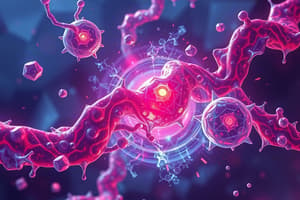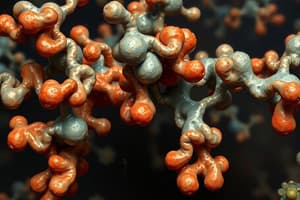Podcast
Questions and Answers
What are precursor metabolites?
What are precursor metabolites?
- Enzymes that catalyze reactions
- Molecules generated by an anabolic pathway
- Proteins that provide structural support
- Any of 12 molecules generated by a catabolic pathway (correct)
What is an active site?
What is an active site?
Functional site of an enzyme, whose shape is complementary to the shape of the substrate.
What is denaturation?
What is denaturation?
Process by which a protein's three-dimensional structure is altered, eliminating function.
What are competitive inhibitors?
What are competitive inhibitors?
What are noncompetitive inhibitors?
What are noncompetitive inhibitors?
What is beta-oxidation?
What is beta-oxidation?
What does a lipase do?
What does a lipase do?
What is the function of proteases?
What is the function of proteases?
Define amphibolism.
Define amphibolism.
What is gluconeogenesis?
What is gluconeogenesis?
What is genetics?
What is genetics?
What are genes?
What are genes?
Define genome.
Define genome.
What is a nucleoid?
What is a nucleoid?
What are histones?
What are histones?
What is the leading strand?
What is the leading strand?
What is the lagging strand?
What is the lagging strand?
What is a genotype?
What is a genotype?
What is a phenotype?
What is a phenotype?
What is messenger RNA?
What is messenger RNA?
What is transfer RNA?
What is transfer RNA?
What is transcription?
What is transcription?
What is translation?
What is translation?
What is a codon?
What is a codon?
What is an anticodon?
What is an anticodon?
What is a mutation?
What is a mutation?
What is a point mutation?
What is a point mutation?
Define frameshift mutation.
Define frameshift mutation.
What are mutagens?
What are mutagens?
What is wild type?
What is wild type?
What is the Ames test?
What is the Ames test?
Of anabolism, catabolism, or both; which breaks down larger molecules into smaller ones?
Of anabolism, catabolism, or both; which breaks down larger molecules into smaller ones?
Of anabolism, catabolism, or both; which is exergonic?
Of anabolism, catabolism, or both; which is exergonic?
Of anabolism, catabolism, or both; which is endergonic?
Of anabolism, catabolism, or both; which is endergonic?
Of anabolism, catabolism, or both; which involves the production of cell membrane constituents?
Of anabolism, catabolism, or both; which involves the production of cell membrane constituents?
What does exergonic mean?
What does exergonic mean?
What does endergonic mean?
What does endergonic mean?
What is an amphibolic reaction?
What is an amphibolic reaction?
Of anabolism, catabolism, or both; which includes metabolism?
Of anabolism, catabolism, or both; which includes metabolism?
What are redox reactions?
What are redox reactions?
What is a redox reaction?
What is a redox reaction?
What does it mean when a reduced molecule has gained electrons?
What does it mean when a reduced molecule has gained electrons?
What is activation energy?
What is activation energy?
What are coenzymes?
What are coenzymes?
Under ideal conditions, how many ATP molecules are gained from the fermentation of one glucose molecule by a bacterium?
Under ideal conditions, how many ATP molecules are gained from the fermentation of one glucose molecule by a bacterium?
Under ideal conditions, how many ATP molecules are gained from the complete aerobic oxidation of one glucose molecule by a bacterium?
Under ideal conditions, how many ATP molecules are gained from the complete aerobic oxidation of one glucose molecule by a bacterium?
The glycolysis pathway is basically what type of process?
The glycolysis pathway is basically what type of process?
What happens when all active sites on substrate molecules are filled?
What happens when all active sites on substrate molecules are filled?
How many ATP molecules are produced in glycolysis after the initial input of two ATP molecules?
How many ATP molecules are produced in glycolysis after the initial input of two ATP molecules?
What is the Krebs cycle?
What is the Krebs cycle?
The final electron acceptor in aerobic respiration is what?
The final electron acceptor in aerobic respiration is what?
What are the main coenzymes that carry electrons in catabolic pathways?
What are the main coenzymes that carry electrons in catabolic pathways?
Flashcards are hidden until you start studying
Study Notes
Metabolic Pathways and Enzymes
- Precursor metabolites are 12 essential molecules generated by catabolic pathways, vital for organic macromolecule synthesis.
- Active sites of enzymes are specifically shaped to fit substrates, enabling catalytic activity.
- Denaturation alters a protein's three-dimensional structure, which disrupts its function.
- Competitive inhibitors block enzyme activity by occupying the active site, preventing substrate access.
- Noncompetitive inhibitors bind to allosteric sites, inhibiting enzyme function without competing for the active site.
Fatty Acid and Lipid Metabolism
- Beta-oxidation is a catabolic process where fatty acids are broken down, forming acetyl-CoA.
- Lipases are water-soluble enzymes responsible for hydrolyzing lipids into glycerol and free fatty acids.
- Proteases are enzymes that degrade proteins into amino acids, functioning outside the cell wall in microbes and involved in inflammatory responses.
Biochemical Integration
- Amphibolism describes pathways integrating both catabolism (breaking down molecules) and anabolism (building up molecules), exemplified by fatty acid beta-oxidation.
- Gluconeogenesis generates glucose from non-carbohydrate sources such as pyruvate and amino acids.
Genetics Fundamentals
- Genetics encompasses the study of inheritance and traits expressed in an organism's genetic material.
- Genes are specific nucleotide sequences that code for proteins or RNA.
- The genome is the complete genetic material in a cell or virus, while the nucleoid comprises nucleic acid monomers.
- Histones are globular proteins found in the chromosomes of eukaryotes and archaea.
DNA and RNA Structure
- The leading strand is continuously synthesized toward the replication fork, whereas the lagging strand consists of short segments (Okazaki fragments).
- Genotype refers to the actual set of genes, differing from the genome which includes non-coding regions.
- Phenotype encompasses the observable traits and characteristics of an organism realized through genetic expression.
RNA and Protein Synthesis
- Messenger RNA (mRNA) conveys genetic information from DNA to ribosomes.
- Transfer RNA (tRNA) brings amino acids to ribosomes based on mRNA sequences.
- Transcription involves converting DNA to RNA, while translation synthesizes polypeptides from mRNA.
Genetic Mutations
- Mutations are permanent changes in the nucleotide sequence of a genome.
- Point mutations affect a few base pairs, whereas frameshift mutations displace subsequent nucleotide triplets.
- Mutagens are agents that induce mutations, and wild type refers to organisms found naturally without mutations.
Energy in Metabolism
- Redox reactions involve electron transfer, with oxidation (loss of electrons) and reduction (gain of electrons).
- Exergonic reactions release energy, typical of catabolic processes, while endergonic reactions require energy, characteristic of anabolic processes.
- Amphibolic reactions can function as either anabolism or catabolism.
ATP and Cellular Respiration
- Anaerobic respiration differs from fermentation, where organic molecules serve as final electron acceptors in fermentation.
- Substrate-level phosphorylation forms ATP through direct transfer of phosphate, while oxidative phosphorylation generates ATP from electron transport processes.
- Glycolysis initiates carbohydrate catabolism, yielding a net gain of 2 ATP molecules.
- The Krebs cycle, consisting of eight reactions, metabolizes acetyl-CoA, producing NADH and FADH2.
- O2 is the final electron acceptor in aerobic respiration, crucial for cellular energy production.
Enzymatic Activity and Regulation
- Saturation occurs when all active sites on enzymes are occupied by substrate molecules, inhibiting further reaction.
- During glycolysis, an initial investment of 2 ATP molecules leads to the net production of 2 ATPs from the process.
- NAD+ and FAD are key coenzymes that transport electrons in catabolic pathways.
Studying That Suits You
Use AI to generate personalized quizzes and flashcards to suit your learning preferences.



